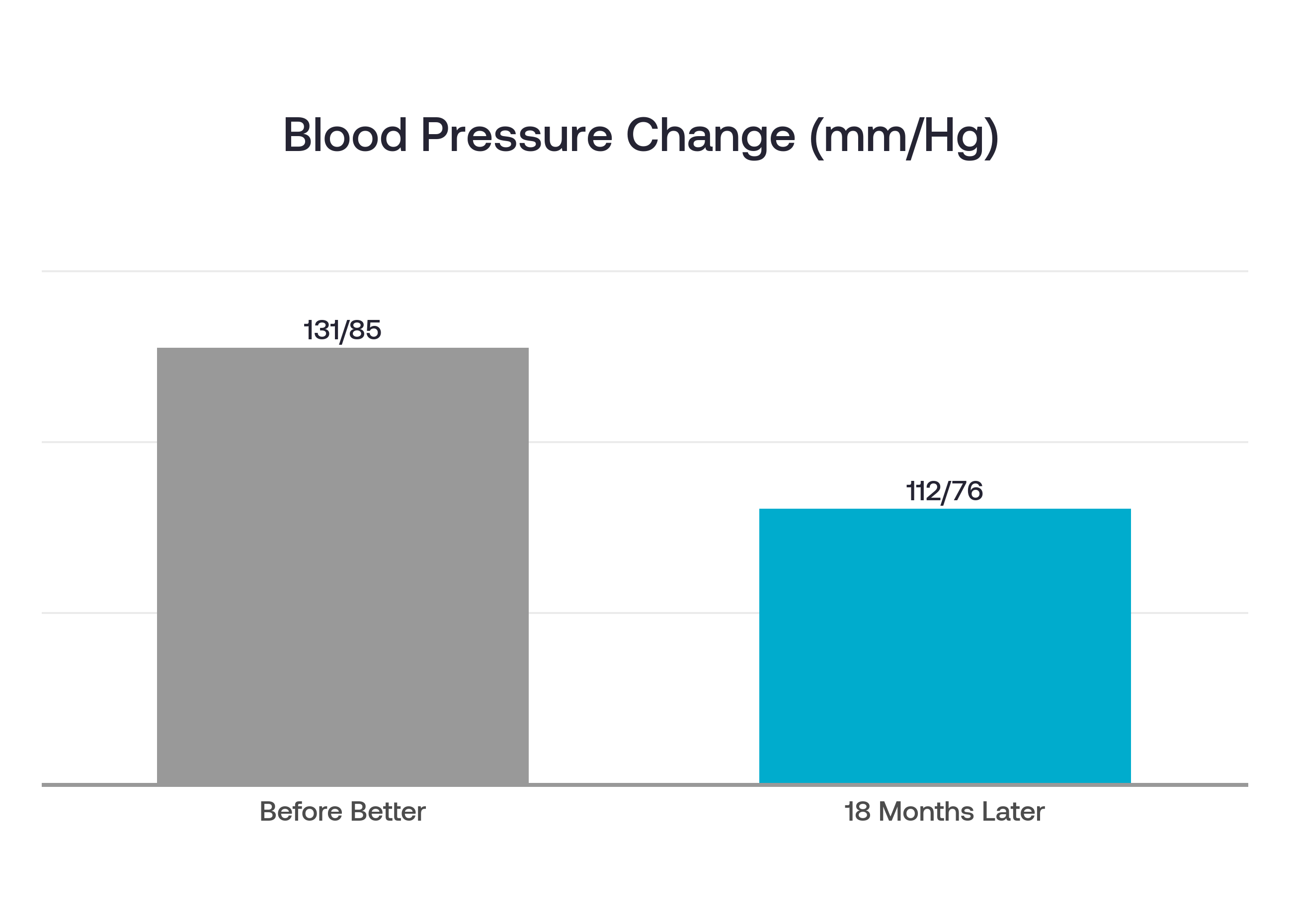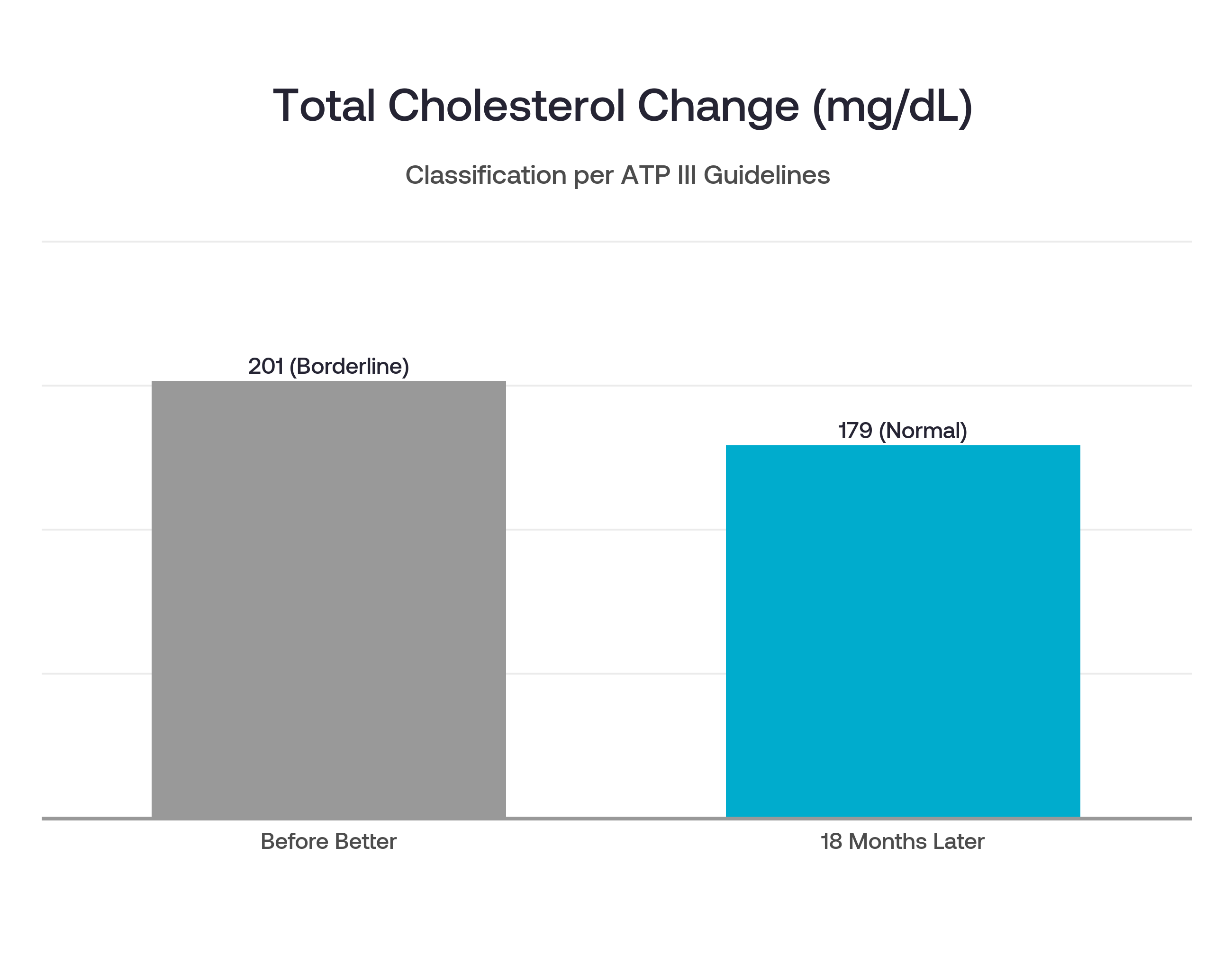Case Study: Wilma, 60

Overview
In 2016, Wilma was diagnosed with type 2 diabetes, high blood pressure and high cholesterol. Her weight at that time was 365 lbs. Although she was able to lose 37 pounds after these diagnoses, Wilma felt she wasn’t receiving adequate information or support from her healthcare team. She enrolled in a Better clinical trial in August of 2017 to learn more about how to manage her diabetes. With a better understanding of her condition, she believed she could empower herself to improve her health.
Medications
Metformin 500mg, 2x per day (diabetes)
Lisinopril 10mg per day (high blood pressure)
Xarelto 20mg per day (blood thinner)
Lipitor 80mg per day (cholesterol)
Other Health Conditions & Concerns
Class 3 obesity
Low energy and low activity tolerance
History of two deep vein thromboses (blood clots in her legs) and a pulmonary embolism (blood clot in her lung)
Family History
Wilma’s mother and sister both had diabetes, were insulin-dependent, and died from complications. She has vivid memories of seeing her mother give herself shots and she didn’t want her own life to follow the same path.
“I didn’t want to end up like my mom or sister. I knew the life of diabetes and I didn’t want it.”
Behavioral Treatment
Challenges & Concerns
Wilma had heard conflicting information about the best dietary pattern for individuals with diabetes. This made it difficult for her to assess the accuracy of the information she read on the internet and left her confused about what to eat.
She was initially hesitant to add carbohydrate-rich whole plant foods back into her diet as she had always thought that people with diabetes should avoid them.
Wilma’s weight and sedentary lifestyle made it difficult for her to walk more than a few minutes at a time.
Wilma felt she had no control over her diabetes. Her primary care physician recommended that she not self monitor her blood sugar values at home because she would be unable to interpret the numbers and there was little she could do to change them.
Behavior Changes
With guidance from Better, Wilma shifted her beliefs about what constitutes a healthy dietary pattern. Despite some initial hesitancy about eating mostly plants, she gradually began to experiment with incorporating more legumes, whole grains and starchy vegetables into her diet. Observing that her blood sugar, weight, and blood pressure improved as she did, she eventually embraced whole plant foods as the primary part of her diet.
Wilma used the Better app to diligently track her behaviors on a daily basis - including the number of plant-based meals eaten, minutes of activity, and her weight. She found self-monitoring to be an extremely helpful strategy for reinforcing new behaviors as she was able to connect changes in behavior to the outcomes she achieved.
Wilma broke down her long-term weight loss goal into smaller, more manageable goals - 10% of her current weight. Each time she met a goal, she would celebrate the accomplishment and then turn her attention to the next milestone. Using a similar incremental approach, Wilma was able to extend her walking from 4 minutes at a time to 90 minutes and now averages 12,000 steps per day.
Wilma researched her new lifestyle changes so she could make informed choices for herself. This growth mindset helped her to approach changes and challenges as part of the behavior change process, viewing her experiences as opportunities to learn. She intentionally sought support from the Better Care Team, peer-community, friends and family.
“I’ve become more aware about everything and I feel better. Now I'm aware of myself and my health. I'm thinking more about my limits. There are things that I can do, possibilities that I'm more willing and able to take on. I didn't have to be content at that low level. I need to learn that this is too low of a bar.”
Results
Wilma has more energy and is active on a daily basis.
She no longer takes medication for diabetes, blood pressure, or cholesterol.
Wilma has lost over 100 lbs and sustained this weight loss for 3 years.
She no longer needs to use a seatbelt extension.
Her “someday” dress has become her “today” dress.
She has confidence in her ability to take on challenges and looks forward to a healthy future.




Takeaways
Through her experience with Better and her own innate curiosity, Wilma learned she could understand and have control over her condition, in contrast to what she had been told by her primary care physician.
Her willingness to explore the evidence and try new things allowed her to approach behavior change as a series of experiments and an opportunity to learn how different choices impacted her health.
Wilma’s journey shows how breaking down larger, long-term goals into smaller, actionable steps can be an effective strategy to create lasting behavior change.
She delights in sharing her Better experience with others and continues to enjoy her own journey. She is confident in her ability to maintain the behavior changes she’s made and looks forward to leading a healthy, active life.


